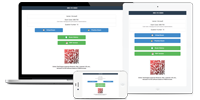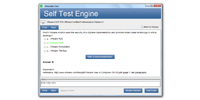간결한 내용
DAA-C01 덤프문제는 다년간의 다양한 시험에 대한 분석을 바탕으로, 시험문제의 주요 발전 경향에 따라 응시자가 직면할 어려움을 정면 돌파하기 위하여 전문가들이 자신만의 경험과 끊임없는 노력으로 제작한 최고품질의 시험자료입니다.다른 교육 플랫폼과 달리 SnowPro Advanced: Data Analyst Certification Exam 시험덤프는 오래된 문제는 삭제하고 새로운 문제는 바로바로 추가하여 덤프가 항상 가장 최신버전이도록 간결하고 눈에 잘 띄는 텍스트로 요약되어 있기에 덤프만 완벽하게 마스터 하시면 DAA-C01 시험패스는 더는 어려운 일이 아닙니다.
우리의 SnowPro Advanced: Data Analyst Certification Exam 시험 덤프 문제는 최고품질의 시험대비 자료입니다. 전문가들이 최신 실러버스에 따라 몇년간의 노하우와 경험을 충분히 활용하여 연구제작해낸 자료라 해당 시험의 핵심문제를 모두 반영하고 있습니다.DAA-C01 덤프로 시험을 준비하시면 시험패스는 더는 어려운 일이 아닙니다. DAA-C01 시험에서 출제 가능성이 높은 문제만 정리한 최신 버전 자료라 가장 적은 문항수로 모든 응시자가 효율적인 시험공부를 할 수 있도록 하고 부담 없이 한번에 DAA-C01 시험을 즉시 통과할 수 있도록 도와드립니다.
진정한 시뮬레이션 환경
많은 응시자 분들이 처음 자격증 시험에 도전하는 것이라 시험보실 때 경험 부족으로 인해 시험시간에 너무 긴장하여 평소 실력을 발휘하지 못하는 경우가 있습니다.이를 피면할수 있도록 미리 SnowPro Advanced: Data Analyst Certification Exam 시험과 비슷한 환경에서 연습하는 훈련을 통해 실제 시험에서 긴장을 완화시키는 것이 좋습니다. 저희는DAA-C01 실제 시험 시뮬레이션 테스트 환경에 해당하는 제품을 가지고 있습니다. 제품 구매후 자신의 계정에 로그인하시고 실제 시험 환경을 체험해 보시면 시험 환경에 적응되어 DAA-C01 시험보실때 문제 푸는 방법을 모색하는 시간이 줄어들어 자신감이 생겨 한방에 시험패스 가능할것입니다.
커리큘럼 소개
대부분의 분들에게 있어서 자격증 시험이 처음일 수 있으므로 자격증 시험과 관련된 많은 정보는 복잡하고 난해할수 있습니다. 하지만 자격증 취득 초보자들의 덤프공부 후기에 따르면 DAA-C01 덤프는 시험의 모든 출제범위와 시험유형을 커버하고 있어 덤프에 있는 문제와 답만 기억하시면 SnowPro Advanced: Data Analyst Certification Exam 시험을 쉽게 패스하여 자격증을 취득할수 있다고 합니다. DAA-C01 시험대비 덤프는 초보자의 눈높이에 맞추어 덤프를 사용하시는 분께서 보다 편하게 공부할수 있도록 엘리트한 전문가들의 끊임없는 연구와 자신만의 노하우로 최선을 다한 자료입니다.덤프의 도움으로 여러분은 업계에서 또 한층 업그레이드 될것입니다.
최신 SnowPro Advanced DAA-C01 무료샘플문제:
1. When customizing data presentations in dashboards through filtering and editing techniques, what benefits do these methods offer? (Select all that apply)
A) Simplified data representation
B) Improved data accuracy
C) Limited data exploration
D) Enhanced data relevancy
2. How does using Snowsight's data loading capabilities impact the overall data preparation process?
A) Streamlines data loading, reducing preparation time
B) Increases data transformation complexities
C) Doesn't support batch data loading
D) Limits data loading to specific file formats
3. When planning for data volume collection, what is an important consideration to ensure scalability and performance?
A) The physical location of data
B) The types of data visualization tools used
C) The expected growth rate of data
D) The data processing capabilities
4. When utilizing geospatial functions in Snowflake, what functionalities do these functions offer?
(Select all that apply)
A) Geometric calculations
B) Data encryption
C) Location-based data analysis
D) Spatial indexing
5. When dealing with semi-structured data in Snowflake, what advantages do native data types offer over traditional relational data types?
A) Native data types limit query complexity and optimization
B) Native data types provide flexibility in handling varied data structures
C) Native data types enforce strict schema requirements
D) Native data types offer higher data integrity and consistency
질문과 대답:
| 질문 # 1 정답: B,D | 질문 # 2 정답: A | 질문 # 3 정답: C | 질문 # 4 정답: A,C,D | 질문 # 5 정답: B |


 393 고객 리뷰
393 고객 리뷰





